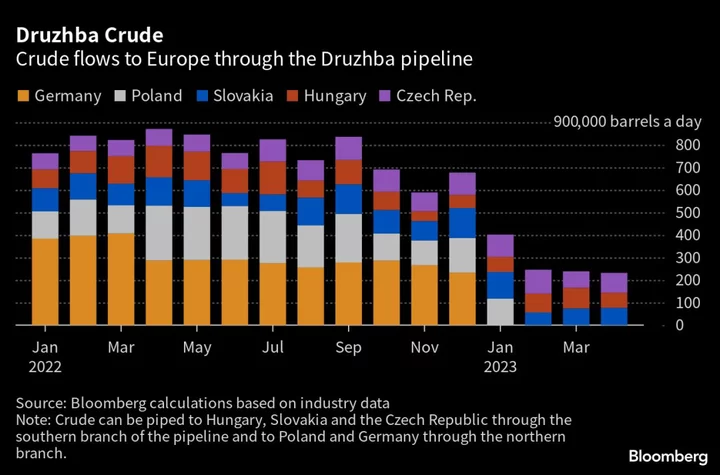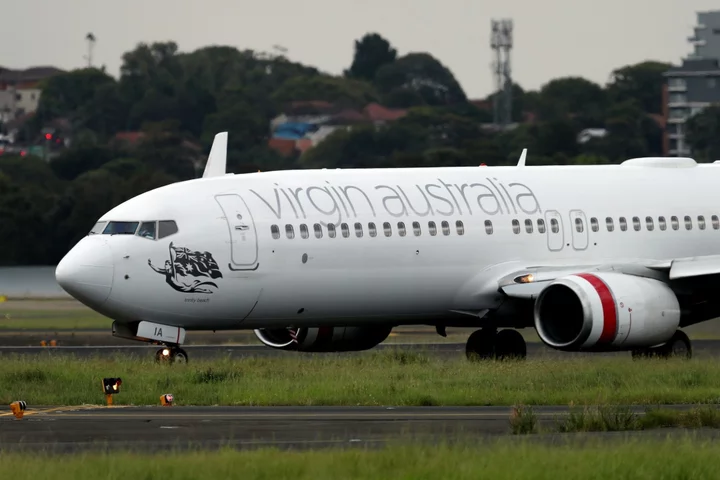Russian crude oil flows to international markets are edging lower, but still show no substantive sign of the output cuts that the Kremlin insists the country is making.
Four-week average seaborne shipments, which smooth out some of the volatility in weekly numbers, fell for the first time in six weeks in the period to May 28, slipping to 3.64 million barrels a day. But crude flows to international markets remain elevated and are still more than 1.4 million barrels a day higher than they were at the end of last year and 270,000 barrels a day up on February, the baseline month for the pledged cut.
The drop in the four-week average flow came as the abnormally high figure for the week ending April 30 dropped out of the calculation. A decline in the weekly figure — a second successive reduction — to 3.5 million barrels a day reflects the absence of any tankers completing loadings at Murmansk during the week, though one tanker was taking on a cargo as the week ended and another commenced on Monday morning.
Moscow is seeking to convince its OPEC+ partners that it has implemented an output cut of 500,000 barrels a day that was due to come into effect in March. That reduction was announced in retaliation for Western sanctions and price caps on Russia’s oil exports designed to punish Moscow for the invasion of Ukraine. The cuts were extended for the rest of the year, in line with voluntary reductions made by several of Russia’s OPEC+ partners that were announced in April and came into effect at the beginning of May.
Russia continues to stress its commitment to the OPEC+ producer group, which is due to meet on June 4 to review the market and its response to mounting worries about the strength of demand. Signs that Russia hasn’t implemented the cuts it promised may displease fellow members.
There is little evidence that the cuts have been made. Moscow has cited the diversion of crude previously piped to Germany and Poland through the Druzhba pipeline as a reason for robust shipments; but the switch happened in January and February, before the output cut was due to come into effect. Flows of Russian crude through the Druzhba pipeline, now limited to deliveries to Hungary, Slovakia and the Czech Republic, have been stable at about 240,000 barrels a day since February.
Industry data seen by Bloomberg showed that the number of active wells across Russia’s oil fields fell in March, with 4,170 taken out of operation, equivalent to 2.6% of the wells that were active in February. Similar data for April show the number of active wells creeping back up, with about 9% of those taken offline the previous month pumping again.
Russian refineries have cut their crude processing in May. Runs fell to 5.24 million barrels a day on average from May 1 to 24, their lowest level in a year. The drop comes as the plants halt some units for traditional spring maintenance before the high-demand season in summer. But there is no sign of a corresponding drop in overseas shipments of refined products.
Russia’s Lifelines
The combined volume of crude on vessels heading to China and India plus smaller flows to Turkey and quantities on ships that haven’t yet shown a final destination fell to 3.58 million barrels a day in the latest four-week period, down from 3.76 million barrels a day in the period to May 21.
As the ultimate destinations of cargoes loading in late January became apparent, flows to China rose to new post-invasion highs, and remained close to those levels in February and the first weeks of March. Historical patterns suggest that most of the vessels currently signaling “Unknown Asia” destinations and heading for the Suez Canal will end up in India, while those loaded onto very large crude carriers off the north coast of Morocco or, more recently, in the Atlantic Ocean, will head to China.
A tanker hauling Urals crude from Ust-Luga has arrived in Cuba, the first Russian crude delivered to the Caribbean nation since February.
Crude Flows by Destination
On a four-week average basis, overall seaborne exports in the period to May 28 were down by 180,000 barrels a day to 3.64 million barrels a day. That’s the first drop in six weeks. More volatile weekly flows also fell, dropping by about 175,000 barrels a day to 3.5 million barrels a day from a revised 3.67 million barrels a day the previous week.
Weekly data are affected by the scheduling of tankers and loading delays caused by bad weather. Port maintenance can also disrupt exports for several days at a time.
All figures exclude cargoes identified as Kazakhstan’s KEBCO grade. Those are shipments made by KazTransoil JSC that transit Russia for export through the Baltic ports of Ust-Luga and Novorossiysk.
The Kazakh barrels are blended with crude of Russian origin to create a uniform export grade. Since Russia’s invasion of Ukraine, Kazakhstan has rebranded its cargoes to distinguish them from those shipped by Russian companies. Transit crude is specifically exempted from European Union sanctions.
-
Asia
Four-week average shipments to Russia’s Asian customers, plus those on vessels showing no final destination, slipped to 3.34 million barrels a day in the period to May 28 from 3.53 million barrels a day in the four weeks to May 21.
While the volumes heading to India appear to have declined from recent highs, history shows that most of the cargoes on ships without an initial destination eventually end up there or in China.
The equivalent of 424,000 barrels a day was on vessels showing destinations as either Port Said or Suez in Egypt, or which already have been or are expected to be transferred from one ship to another off the South Korean port of Yeosu. Those voyages typically end at ports in India or China and show up in the chart below as “Unknown Asia” until a final destination becomes apparent.
The “Other Unknown” volumes, running at 321,000 barrels a day in the four weeks to May 28, are those on tankers showing no clear destination. Most of those cargoes originate from Russia’s western ports and go on to transit the Suez Canal, but some could end up in Turkey, while other cargoes end up being transferred from one vessel to another, either in the Mediterranean or, more recently, in the Atlantic Ocean.
-
Europe
Russia’s seaborne crude exports to European countries were unchanged at 63,000 barrels a day in the 28 days to May 28, with Bulgaria the sole destination. These figures do not include shipments to Turkey.
A market that consumed about 1.5 million barrels a day of short-haul seaborne crude, coming from export terminals in the Baltic, Black Sea and Arctic has been lost almost completely, to be replaced by long-haul destinations in Asia that are much more costly and time-consuming to serve.
No Russian crude was shipped to northern European countries in the four weeks to May 28.
Exports to Turkey, Russia’s only remaining Mediterranean customer, rose to 240,000 barrels a day in the four weeks to May 28, the highest since December. Flows to Turkey topped 425,000 barrels a day in October.
Flows to Bulgaria, now Russia’s only Black Sea market for crude, were unchanged at 63,000 barrels a day, equaling their lowest since April 2022.
Flows by Export Location
Aggregate flows of Russian crude slipped to 3.5 million barrels a day in the seven days to May 28, from a revised 3.67 million barrels a day the previous week. The absence of shipments from the Arctic was partly offset by a surge in the flow from the Black Sea port of Novorossiysk.
Figures exclude volumes from Ust-Luga and Novorossiysk identified as Kazakhstan’s KEBCO grade.
Export Revenue
Inflows to the Kremlin's war chest from its crude-export duty fell by $4 million to $47 million in the seven days to May 28 from a revised figure for the previous week. Four-week average income fell by $3 million to $50 million.
President Vladimir Putin ordered his government to fine-tune existing indicators and establish additional ones to calculate oil prices for tax purposes in order to reduce the discount to global crude prices. Russia’s government calculates oil taxes using a discount to Brent, which sets the floor price for the nation’s crude for budget purposes. If Russian oil trades above that threshold, the Finance Ministry uses the market price for tax calculations, as has been the case in recent months. From July the discount is currently set at $25/bbl, though this may now be narrowed.
The duty rate for May is $1.96 a barrel, based on a Urals price of $51.15 a barrel between March 15 and April 14. The rate for June has been set at $2.21 a barrel, based on an average Urals price of $55.97, which was $23.90 a barrel below Brent during the period between April 15 and May 14.
Origin-to-Location Flows
The following charts show the number of ships leaving each export terminal and the destinations of crude cargoes from the four export regions.
A total of 33 tankers loaded 24.5 million barrels of Russian crude in the week to May 28, vessel-tracking data and port agent reports show. That’s down by 1.25 million barrels from the previous week’s revised figure. Destinations are based on where vessels signal they are heading at the time of writing, and some will almost certainly change as voyages progress. All figures exclude cargoes identified as Kazakhstan’s KEBCO grade.
The total volume on ships loading Russian crude from Baltic terminals edged lower to 1.67 million barrels a day, down by 100,000 barrels a day from the previous week.
Shipments of Russian crude from Novorossiysk in the Black Sea surged to their highest since Bloomberg began tracking weekly flows at the start of 2022, rising to 790,000 barrels a day. No cargoes of Kazakhstani crude were loaded at the port during the week.
Arctic shipments fell to zero, with no tankers completing loading in the week to May 28. One tanker began taking on a cargo on Sunday, one commenced on Monday and two more are heading to the port. There has been no apparent slowdown in the volume of crude arriving at Murmansk from loading terminals along Russia’s Arctic coast, suggesting that the drop in flows from Murmansk reflects the scheduling of tankers, rather than a cut in production from Russia’s northern fields.
Ten tankers loaded at Russia’s three Pacific export terminals, unchanged from the revised number for the previous week. The volume of crude shipped from the region was also unchanged, at 1.03 million barrels a day.
The volumes heading to unknown destinations are mostly Sokol cargoes that recently have been transferred to other vessels at Yeosu, or are currently being shuttled to an area off the South Korean port from the loading terminal at De Kastri. Most of these are also ending up in India.
Some Sokol cargoes are now being transferred a second time in the waters off southern Malaysia. A small number of ESPO shipments are also being moved from one vessel to another in the same area. All of these cargoes have, so far, gone on to India.
NOTES
Note: This story forms part of a regular weekly series tracking shipments of crude from Russian export terminals and the export duty revenues earned from them by the Russian government.
Note: All figures exclude cargoes owned by Kazakhstan’s KazTransOil JSC, which transit Russia and are shipped from Novorossiysk and Ust-Luga as KEBCO grade crude.
Note: Weeks have been revised to run from Monday to Sunday, rather than Saturday to Friday. This change has been implemented throughout the data series and previous week’s figures have been revised.
Note: The next update of this story will be published on Tuesday June 6, with future updates also to be published on Tuesdays.
--With assistance from Sherry Su.









